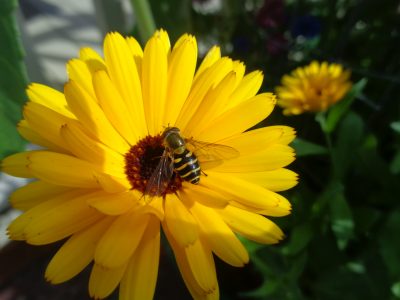A Good Defense
Someone recently said to me, “A gardener wears many hats”. I thought of this when I was doing some reading for a quiz for the Alaska Master Gardener Online Course. A good defense against pests is to learn as much as you can about all insects, harmful and beneficial alike. This calls for our entomology hats!
Getting to Know Bugs
Did you know female aphids give live birth to pregnant females? This is how you can end up with a real problem before you even know you have one. From personal experience I can tell you, aphids in your underwear is a sure sign you have an aphid issue. Did you know that besides lady beetles, there are many other insects that also eat aphids? Hover Fly is a beneficial insect that eats aphids, and is also a pollinator. I was pleased to capture a beautiful photo of one in my mother’s garden a few days ago.

Knowledge Is Power
Other details about bugs can be crucial in determining if and when another form of pest control is in order. For example, an insect which goes through a complete metamorphosis can be much less harmful as an adult than in larval stage. Using plastic mulch or row covers to prevent the laying of eggs around plant bases can be an effective form of pest control in such cases. Knowing if a pest is soft-bodied could help you decide on a particular product such as diatomaceous earth, which can be an effective form of pest control in cases of soft-bodied insects.
Good Information is Key
The information I’ve had access to through the Alaska Master Gardener Online Course is good stuff, I especially liked the entomology lesson. I wish I could retain every word I’ve read and recall every picture, but there has been a lot of information to read through. I’m glad I’ll have all of it to look back on. I’ll certainly be referencing the Alaska’s Sustainable Gardening Handbook.